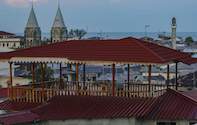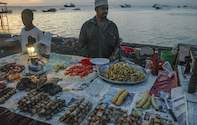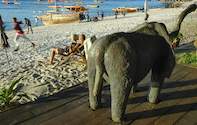
Most travellers to Tanzania come to conquer Kilimanjaro or watch wildlife in famous Serengeti National Park. But afterwards everyone heads off to relax on Zanzibar.
Jeremy Jowell soaks up the sun
Crumbling yellow buildings with broken balconies rise above me as I amble around the maze of narrow twisting streets. Black-veiled women dressed in colourful kangas hurry mysteriously past. Muslim men skin sugar cane and sweat in the humid heat. Three shy schoolgirls smile at me from the entrance of an intricately carved wooden door while small children in a darkened classroom recite verses from the Koran.

This is Stone Town, the centre of all trade and transport on Zanzibar and the most mythical must-see destination on the East African coast. Normally I pride myself on my sense of direction, but here in the snaking alleyways I'm hopelessly lost and walk around in circles, mesmerised by the magic of the Stone Town world.
All travellers to the island idyll of Zanzibar spend some time here, caught up in a whirl of sightseeing and shopping. Take time to admire Stone Town's famous wooden doors and the unique blend of Arabic, Indian, African and European architecture while bargaining your way from one curio shop to another. But if you discover an interesting shop, go inside immediately, because chances are you'll never find the same place again.
At the end of a hot sweaty day, the best place for sundowners is Africa House. Relax on the balcony with a beer as you watch the golden sunset and white-sailed boats called dhows drifting slowly by. For dinner, Stone Town has a wide variety of good restaurants. But for a meal with a difference, wander down to Forodhani Gardens at the waterfront for the biggest seafood buffet in the world.

Every evening after sunset, good-natured vendors set up their stalls filled with meat and chicken kebabs, mounds of kingfish, calamari, marlin, tuna, barracuda, crabs, lobster and prawns, all barbecued on the coals. Then to wash it down, try a glass or two of sweet sugarcane juice, manually squeezed out with the use of an archaic machine.
In the mid 19th century, Zanzibar was the centre of east Africa's slave trade with nearly 30 000 slaves passing through Stone Town's market every year. Today, the Anglican Cathedral stands on the site of the slave market but tourists can still visit the holding chambers underground.
There are several popular day tours to take outside Stone Town. One is a trip south to swim with the dolphins at Kizimkazi. Another is a spice tour to see plantations of cloves, vanilla, cinnamon and nutmeg, for which Zanzibar is famous. All day trips can be arranged through any tour operator or hotel.
Several islands that make up the Zanzibar archipelago, many of which are ringed by coral reefs. If you have time on your hands and a taste for adventure, take a trip to Pemba Island, a pristine paradise 50 km to the north. Pemba is lush and hilly and offers some of the best scuba diving in the area.
Chumbe Island, just 30 minutes by boat from Stone Town, is also well worth a visit. This exclusive island has been declared a marine national park and the snorkelling on the pristine reef is the best I've ever experienced.

Despite the many attractions of Stone town, the main drawcard on Zanzibar is undoubtedly the beautiful beaches and warm seas. Situated on the northern tip, Nungwi is a laid back oasis of lazy days and tropical delights. It is the major dhow-building centre on Zanzibar and the local men can often be seen hard at work on their boats. Nearby, Mnemba Atoll has an abundance of marine life and astounding turquoise waters. Even if you're not a scuba diver, a day's snorkelling trip here is a must.
But the east coast of the island has the best beaches, with endless stretches of white sand and palm-fringed shores. The mini bus taxi fetches me at 8am sharp for the journey out to Jambiani. On the way, we pass through the Jozani Forest where the red colobus monkey lives.
Jambiani is a picturesque beach several kilometres long. Coconut palms sway in the gentle breeze, overlooking a tranquil translucent sea. The village is home to 7000 people, most of whom are fishermen or farmers who cultivate cassava, maize, tomatoes and bananas. After a dhow trip out for a snorkel on the reef, I amble through the village where small smiling children rush to greet me with a friendly chorus of "jambo".
The next few days pass quickly in a pleasurable haze of stunning sunrises, bicycle rides, afternoon siestas and delectable seafood. All too soon, it's time to leave. But the Zanzibar bug has bit me hard. As my aeroplane ascends over the blue Indian Ocean, I'm already making plans to come back.
Copyright © 2004 Jeremy Jowell.

 Zanzibar Hotels and Beach Lodges - Known as the legendary Spice Island, the Zanzibar coast of Tanzania epitomizes all that stands for Africa...
Zanzibar Hotels and Beach Lodges - Known as the legendary Spice Island, the Zanzibar coast of Tanzania epitomizes all that stands for Africa... Zanzibar is actually the name given to a cluster of islands that nestle in the waters of the Indian Ocean just off the coast of mainland Tan...
Zanzibar is actually the name given to a cluster of islands that nestle in the waters of the Indian Ocean just off the coast of mainland Tan...